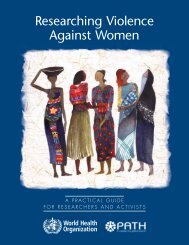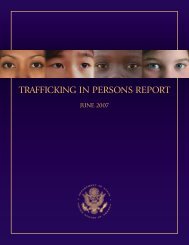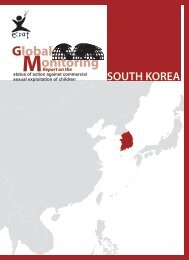Download PDF - Violence Against Children - East Asia and the ...
Download PDF - Violence Against Children - East Asia and the ...
Download PDF - Violence Against Children - East Asia and the ...
Create successful ePaper yourself
Turn your PDF publications into a flip-book with our unique Google optimized e-Paper software.
ecommendations<br />
• Advocate to every level of government for<br />
policy development in <strong>the</strong> best interests of<br />
children; for decisions <strong>and</strong> policies that<br />
support, not suppress, important<br />
grassroots initiatives for child protection.<br />
• Consider <strong>the</strong> potential of government<br />
bodies, NGOs, <strong>the</strong> media, <strong>and</strong> cultural or<br />
faith-based groups to be partners in<br />
changing attitudes <strong>and</strong> reducing risks to<br />
children. As one example, education<br />
systems could incorporate <strong>the</strong> CRC into<br />
curriculum as a key mechanism for child<br />
development, <strong>and</strong> also into staff training.<br />
• Develop <strong>and</strong> streng<strong>the</strong>n inter-agency<br />
networking, cooperation <strong>and</strong> partnerships,<br />
in order to bring out <strong>and</strong> extend <strong>the</strong><br />
strengths of each agency’s approach; address<br />
local child protection issues in ways that are<br />
not possible for a single agency to achieve;<br />
<strong>and</strong> build civil society. Experience shows <strong>the</strong><br />
benefit of active coalitions working to<br />
address an issue of shared concern.<br />
• Invest in research <strong>and</strong> development for<br />
<strong>the</strong> valuable return of new partnerships,<br />
products <strong>and</strong> skills.<br />
• Engage <strong>the</strong> corporate sector to promote<br />
<strong>and</strong> pursue <strong>the</strong> application of child-friendly<br />
practices in a range of areas. To <strong>the</strong> degree<br />
that <strong>the</strong>ir presence <strong>and</strong> investment is valued<br />
by governments, foreign corporations can<br />
be an important influence on country policy<br />
<strong>and</strong> practice. Many corporations have ample<br />
resources to implement effective measures.<br />
• Participate wherever possible in national<br />
working groups, in order to ensure that<br />
concerns emerging from field work are<br />
represented; ideally, have staff positions<br />
dedicated to promoting structural change<br />
<strong>and</strong> advocating from experience.<br />
• Support in-country structures that are<br />
effective in linking NGOs with government<br />
<strong>and</strong> o<strong>the</strong>r actors on child protection, to<br />
promote fur<strong>the</strong>r collaboration.<br />
• Increase collaboration with universities,<br />
<strong>and</strong> national <strong>and</strong> regional coalitions (such as<br />
<strong>the</strong> Regional Working Group on Child<br />
Labour) to avoid duplication of research<br />
<strong>and</strong> address gaps in child protection.<br />
• Bridge <strong>the</strong> gap between project-level<br />
responses <strong>and</strong> advocacy that impacts on<br />
lives locally, <strong>and</strong> responses <strong>and</strong> advocacy at<br />
<strong>the</strong> international level. 7 This may mean<br />
engaging in advocacy targeted at donors<br />
such as <strong>the</strong> World Bank <strong>and</strong> <strong>Asia</strong>n<br />
Development Bank, or UN agencies such<br />
as UNICEF, UNESCO or <strong>the</strong> ILO.<br />
• Get important messages, whe<strong>the</strong>r of good<br />
practice or emerging problems, into <strong>the</strong><br />
public arena. One aspect of globalisation is<br />
<strong>the</strong> increased availability, speed <strong>and</strong> influence<br />
of information. Initiatives that work well to<br />
address child protection in one setting can,<br />
if communicated in a timely <strong>and</strong> accessible<br />
way, influence program designs in o<strong>the</strong>r<br />
districts, countries <strong>and</strong> regions.<br />
Human capacity development<br />
Organisations active in development have a<br />
key role (<strong>and</strong> responsibility) in promoting child<br />
protection in <strong>the</strong>ir areas of operation <strong>and</strong><br />
influence. To this end, capacity building for staff<br />
<strong>and</strong> partners on child development, protection<br />
<strong>and</strong> responses has been an expressed need<br />
across <strong>the</strong> countries of this study.<br />
• Invest in capacity building of staff,<br />
counterparts, community members <strong>and</strong><br />
children. All are important.<br />
• Implement training in core competencies<br />
for staff <strong>and</strong> counterparts on child<br />
development, child protection <strong>and</strong><br />
local/international laws/mechanisms that<br />
protect children. Ensure <strong>the</strong> thorough<br />
implementation of organisational child<br />
protection policies through adequate<br />
financial <strong>and</strong> human resource allocation.<br />
• Provide training <strong>and</strong> resources to equip<br />
program staff to analyse information<br />
from projects <strong>and</strong> use this to effectively<br />
advocate through national, regional or<br />
international forums on issues of child<br />
protection. Increased localisation, scale of<br />
operational area <strong>and</strong> increased reporting<br />
requirements from donors warrant<br />
systematised training resources that are<br />
responsive to local contexts <strong>and</strong> needs.<br />
7<br />
Every Girl Counts, World Vision, 2001<br />
87

















